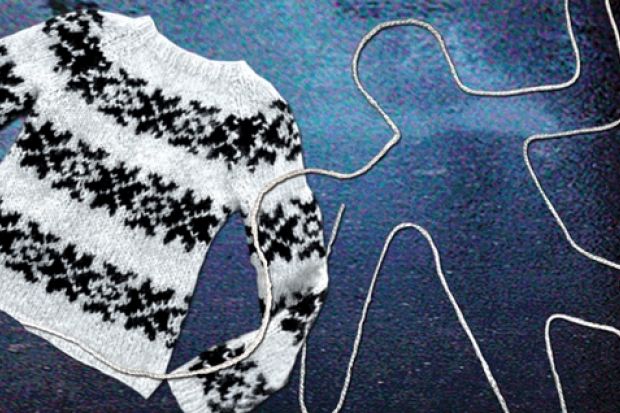Eight episodes of The Killing II have now passed without a single character commenting on Detective Inspector Sarah Lund's jumpers (BBC Four, Saturday 10 December, 9pm and 10pm). If her colleagues notice them at all, they probably think, "Yes, that's sensible attire, the winters here in Denmark are very cold." And then they get back to trying to find out who is behind a series of gruesome murders. But critics, unable to cope with the intricate knitwear of the plot, have seized gratefully on Lund's woollens instead. Honestly, you'd think they had never seen a woman in a Faroese sweater before. Well, you won't find any fashion chit-chat here.
Lund first appears modelling a lovely yellow number while working for passport control in Gedser, on the southernmost tip of Denmark. She had been banished there because her maverick attitude had led indirectly to the death of her partner. The small port was an inspired choice because Lund's glum features would be enough to make anyone seeking entry to the country turn back immediately. Her repatriation to the police department to help investigate the murder of a lawyer seemed only to deepen her gloom. So far, she has smiled once. In Sweden, would you believe? Home of Ingmar Bergman, who confessed that he could not watch his films because they made him so depressed. Lund's return was marked by the donning of a plain red woolly that perfectly complemented the bloodied corpses appearing around Copenhagen.
Each episode begins with highlights from the previous weeks. This is a good idea as I am constantly forgetting things. The story revolves around the shooting of a civilian family in Afghanistan. A soldier called Jens Peter Raben claims that an officer called Perk was responsible, but the army denies that the killings ever took place. Meanwhile, members of Raben's squad who witnessed the atrocity are being slaughtered in a semi-ritualistic manner. Trying to find out who is responsible develops into an examination of Danish society; of its involvement in Afghanistan, of its treatment of Muslims and of its political system.
This makes The Killing II more of a thriller than a detective story; it exposes what is rotten in the state of Denmark. The genre was originally American and now is one of the most popular forms in Scandinavian countries. We are better known for our detective fiction. For us, murder is a local affair, as English as the village fete. The enduring popularity of Poirot and Miss Marple are proof that there will always be some corner of a country house where the tea will be forever poisoned; but, no matter for whom the kettle boils, it will not be an important death. The murderer will be exposed and life will go on as before. The church clock will chime and the talk will be of the weather and the garden. The gentlemen will dress for dinner and the ladies will float to the table on a cloud of their own fragrance. There won't be a jumper in sight.
Alarmed at the power of her red sweater to dramatically shorten the life expectancy of the remaining members of Raben's happy band, Lund abandons it for a creation in cream and brown whose muted tones seem a more accurate reflection of her personality. She's in the hospital corridor, waiting to hear how Raben is after he was shot by her partner, Ulrik Strange. Her boss, Lennart Brix, is there, too. No matter what time of day it is, he always looks as if he has been brought in after having been left out overnight in a heavy frost. His hair sparkles and his facial muscles are so frozen that his sole concession to acting is restricted to a frown. When he speaks, it sounds as if he is crunching ice, although that may just be the grinding of vowels and consonants that is known universally as Danish. Brix is worried because Raben has identified Strange as Perk. If that's the case, then it's bad news for Lund, who rather fancies him.
Thomas Buch, the justice minister, faces dismissal because of his claims that the prime minister may have suppressed evidence that an atrocity was indeed committed. His staff find him getting drunk at the Ministry of Integration, where he is rehearsing his arguments to a group of baffled Africans. A journalist gives Buch some new information that sends him to the gents in search of Erling Krabbe, leader of the People's Party, who shares his suspicions about the prime minister. The sight of Buch on his hands and knees staring under cubicle doors is one of the lighter moments of the drama. But it can't compare with Lund marching into the showers to speak with another possible suspect. Both were very professional. She didn't comment on his nudity and he didn't say anything about her jumper.
Register to continue
Why register?
- Registration is free and only takes a moment
- Once registered, you can read 3 articles a month
- Sign up for our newsletter
Subscribe
Or subscribe for unlimited access to:
- Unlimited access to news, views, insights & reviews
- Digital editions
- Digital access to THE’s university and college rankings analysis
Already registered or a current subscriber? Login
